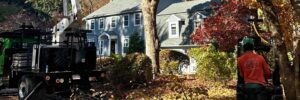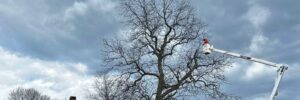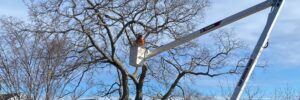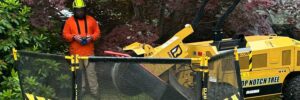When South Shore homeowners call asking, "How much will tree removal cost?" they're often surprised there isn't a simple, one-size-fits-all answer. Tree removal pricing depends on multiple factors, from the size and species of your tree, its location on your property, and local permit requirements in towns throughout Norfolk and Plymouth Counties.
At Top Notch Tree, we believe in pricing transparency. While every job is unique, understanding typical price ranges and cost factors helps you budget for your tree removal project and know what to expect when we provide your estimate.
Key Takeaways
- Small trees (under 35 feet) typically cost $500 to $1,200 for removal on the South Shore.
- Medium-sized trees (35-60 feet) range from $1,500 to $3,000, depending on complexity and location.
- Large trees (60+ feet) start at $2,500 and can reach $ 6,000 or more, depending on size and access challenges.
- Multiple tree projects benefit from shared mobilization costs, with crane crews running $3,000-$4,000 for half-day service.
- Location factors, such as power lines, property access, and local South Shore permit requirements, significantly impact the final pricing.
How Does Tree Size Affect Removal Pricing on the South Shore?
Tree size is the primary factor in determining removal cost because it directly affects the equipment needed, time required, and safety precautions necessary. Larger trees require more specialized equipment, additional crew members, and generate significantly more debris that needs to be processed and removed.
A small ornamental tree, for instance, might be removed with basic climbing gear and a pickup truck, while a 70-foot oak requires crane assistance, a full crew, chippers, and log trucks. The difference in complexity – and required resources – is reflected in the range of service costs.

Small Tree Removal (Under 35 Feet): $500-$1,200
Small trees, such as ornamental maples and dogwoods, or young shade trees, typically fall within this price range. These removals can often be completed using our bucket truck, with minimal crane work required. Easily accessible trees with straightforward removal fall at the lower end of this range, while trees near structures, utility lines, or valuable landscaping that requires extra care reach the higher end.
In South Shore communities, small tree removal also often involves protecting established gardens, stone walls, or proximity to historic homes common in areas like Cohasset Village or Hingham Center – factors that can push pricing toward the higher end of the range.
Medium Tree Removal (35-60 Feet): $1,500-$3,000
Medium-sized trees represent the majority of residential tree removal projects on the South Shore. This category includes mature maples, oaks, and most pine trees found in coastal Massachusetts properties. These trees typically require crane assistance for safe removal, especially when located near homes or other structures.
The wide price range reflects the complexity differences within this size category. A 40-foot maple with clear access might fall toward the lower end, while a 55-foot oak growing between your house and your neighbor's property will require more technical rigging and time.
Large Tree Removal (60+ Feet): $2,500-$6,000+
Large, mature trees require our full crane capabilities and experienced crew to remove safely. These are often the stately oaks, large pines, or mature maples that define South Shore properties. Trees in this category frequently require sectional removal, with each piece carefully lowered to avoid damage to structures, landscaping, or neighboring properties.
The upper end of this range typically involves trees with complex removal challenges: tight quarters, multiple power lines, or trees that have grown into unusual positions over decades. Legacy trees, common to established South Shore neighborhoods, also often fall into this category.
How Does Removing Multiple Trees at Once Help Save Money?
Removing multiple trees at once saves money because you share the mobilization cost across several removals. When we bring our crane crew to your property, a significant portion of the expense involves transporting equipment, setting up the crane, and preparing the work site.
What Are Mobilization Costs in Tree Removal?
Mobilization costs are the base expenses of delivering equipment like the crane, chipper, and log truck to your property and setting up the work site. Whether we’re removing one tree or several, these setup and breakdown costs remain largely the same.
How Much Does Half-Day vs. Full-Day Crane Service Cost?
A half-day crane service typically costs $3,000–$4,000 and can handle two to three medium trees or one large tree with additional smaller removals. A full-day crane service ranges from $6,000–$8,000 and allows us to remove multiple large trees or clear significant areas of your property.
Can You Bundle Multiple Tree Removals to Save Money?
Yes, you can often save money by bundling multiple tree removals because the mobilization costs are shared across several jobs. Even if not all trees require immediate removal, addressing them together can provide better value than scheduling separate visits for each one. During our property assessment, we can identify which trees should be removed now and which can wait, helping you plan and budget more effectively.
What Drives Tree Removal Costs in Coastal Massachusetts?
Beyond tree size, several factors specific to South Shore properties significantly impact removal costs.
How Property Access Affects Tree Removal Costs
Property access plays a major role in tree removal costs. The harder it is to reach a tree with equipment, the more time, labor, and planning are required.
- Backyard Location: Trees in backyards require additional planning for equipment access. If our crane can't reach from the street, we may need smaller equipment or manual rigging techniques, which increases labor time and complexity.
- Fencing and Landscaping Protection: South Shore properties often feature established landscaping, stone walls, or fencing that requires protection during tree removal. We use plywood, ground mats, and careful planning to preserve your property's existing features.
- Proximity to Pools and Structures: Trees near pools, patios, or close to homes require additional rigging and precision work. Each cut must be carefully planned to avoid property damage.
What Happens When Tree Removal Near Power Lines Requires Utility Coordination
Trees growing near power lines require coordination with utility companies and specialized techniques. In some cases, the utility company may need to temporarily shut off power or assist with the removal. This coordination can affect both timing and cost.
Secondary lines (the lines running from the street to your house) are often the homeowner's responsibility and can complicate removal planning. And unlike the primary power lines that utility companies handle, homeowner-owned secondary lines may require you to coordinate power shutoffs or temporary disconnections, potentially adding time and complexity to your tree removal project.
Do You Need a Permit for Tree Removal on the South Shore?
Some South Shore communities require permits for tree removal, particularly for large trees or trees in protected areas. Requirements vary by town and can involve factors like wetland proximity, tree size, or location in historic districts.
Fortunately, we're familiar with local requirements throughout the area and can guide you through any permit process needed for your project.
How Tree Species, Health, and Root Systems Impact Removal Costs
Not all trees are equally difficult to remove. The species, overall health, and root system can dramatically affect the time, equipment, and techniques required. These factors often explain why two trees of similar size may have very different removal costs.
- Species Characteristics: Some trees are naturally more challenging to remove. Large oaks require careful sectioning due to their dense, heavy wood. Pine trees can be unpredictable due to their height and potential for wind damage.
- Tree Health: Dead, diseased, or damaged trees often cost more to remove due to unpredictability and safety concerns. Healthy trees are typically more predictable during removal.
- Root System Considerations: Trees with extensive root systems or those planted in challenging locations may require additional work around underground utilities or septic systems.
Why Accurate Estimates Require Property Visits
While we can provide general price ranges, accurate estimates require seeing your specific situation in person. Every property presents unique challenges that significantly impact both the approach we'll take and the final cost, and we always evaluate every contributing factor to determine the safest and most efficient removal method for your trees.
Phone estimates are a great starting point, but they can't account for:
- Exact access routes for our equipment
- Proximity to structures, utilities, or valuable landscaping
- Tree condition and species-specific challenges
- Soil conditions that might affect crane placement
- Neighboring property concerns
What to Expect During a Top Notch Tree Assessment
During our property visit, we assess multiple factors:
- Tree Evaluation: We examine tree size, health, and species to determine the safest removal method.
- Site Analysis: We identify the best equipment access routes and crane placement options while considering protection for your existing landscape.
- Utility Assessment: We locate and evaluate any power lines, underground utilities, or other infrastructure that could affect the removal process.
- Option Discussion: We explain different approaches when multiple methods are possible, helping you understand the trade-offs between cost, timing, and impact on your property.
How We Help You Stay Within Budget on Tree Removal
Tree removal can often be approached in more than one way, and not every option carries the same cost. We help you find solutions that fit your property needs while keeping expenses manageable. Some of the ways we do this include:
- Timing Considerations: Scheduling removals during the dormant season can sometimes reduce costs.
- Partial vs. Complete Removal: In some cases, removing only high-risk sections instead of the entire tree is a safe, budget-friendly choice.
- Stump Grinding Options and Timing: You may choose immediate grinding or delay it to spread costs out.
- Cleanup and Disposal Preferences: Adjusting how much cleanup we handle versus what you manage can impact the overall price.
By walking through these choices together, we ensure you understand exactly what your project involves and can make the decision that best fits your property, budget, and timeline.
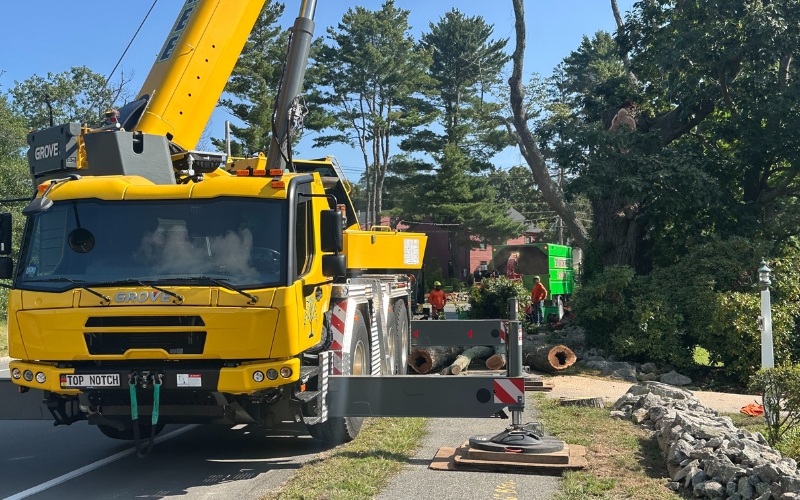
Frequently Asked Questions About Tree Removal Costs
Is stump grinding included in tree removal pricing?
Stump grinding is not included in tree removal pricing because we consider it a separate service. Tree removal pricing covers cutting the tree down to ground level, cleanup, and debris removal. Stump grinding can be done at the time of removal or scheduled separately, depending on your preferences and timeline.
What's included in cleanup and debris removal?
Cleanup and debris removal include all branches, leaves, and materials from the tree removal process. We chip smaller branches on-site when possible, haul away larger logs with our log truck, and always aim to leave your property cleaner than we found it.
Do you offer payment plans for large projects?
We require payment in full upon completion of work. For large projects, we're happy to discuss the work timeline and any questions about payment during your estimate appointment.
How do South Shore property conditions affect pricing?
Coastal conditions, mature landscaping, and property layout typical of South Shore homes can all impact pricing. Factors like established gardens, stone walls, narrow lot access, and proximity to neighboring homes require additional care and planning.
When might permits be required for tree removal?
Permit requirements vary by town and tree location. Trees in wetland buffer zones, trees over certain sizes, or trees in historic districts may require permits. We'll identify any permit requirements during your property assessment and help guide you through the process.
Get Accurate Tree Removal Pricing for your South Shore Property from Top Notch Tree
Understanding typical tree removal costs helps with budgeting, but the only way to get precise pricing for your specific project is through an on-site assessment. What looks like a straightforward removal from the street might involve complex rigging around power lines, require special equipment for tight access, or need extra care to protect established landscaping – all factors that influence your investment.
During your free consultation, we'll evaluate these cost factors firsthand, explain how they apply to your situation, and provide detailed pricing with no hidden fees. This ensures you know exactly what your tree removal investment will be before any work begins.
Begin your tree removal project today by contacting Top Notch Tree at 781-871-8008 for a free, no-obligation property assessment. We'll walk your property, discuss your options, and provide detailed pricing for your South Shore tree removal project. Trust us with your trees – and your property.




